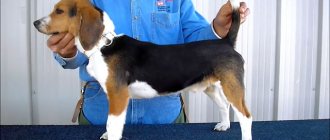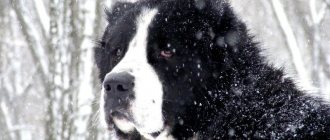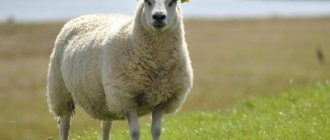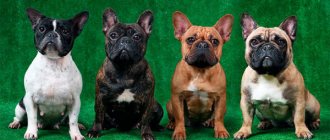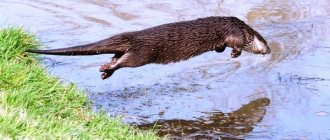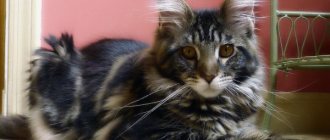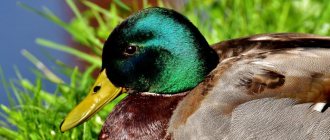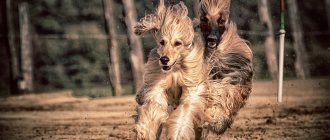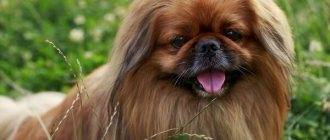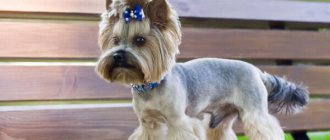Breeding and keeping fat-tailed sheep
Before purchasing young fat-tailed sheep, you should carefully read the rules for their maintenance and breeding.
It is more profitable to maintain a livestock of at least twenty heads, so it is better to refuse offers to sell 1-2 rams. From a large flock you can get a sufficient amount of products (meat, lard, milk and wool), while spending less time, effort and money. However, it is worth considering that maintaining such livestock will require compliance with certain conditions.
First of all, it is necessary to have a large pasture, since sheep spend most of their time grazing freely.
Although the animal is quite unpretentious, they cannot graze in forest and swampy areas, since the high acid content in the pasture inevitably causes poisoning.
Since livestock grazing occurs about 200 days a year (with rare exceptions), care must be taken to ensure that the animals do not run away. To do this, the flock should be provided with a leader and guards. Usually the role of leader is assigned to the shepherd himself, a horse or a dog.
In winter, the rams are placed in a dry shed, in which the optimal temperature should not be lower than +8 degrees. It must be remembered that in a damp room, sheep are more susceptible to colds and often suffer from joint diseases.
To prevent infection, animals are vaccinated. A very important condition is regular veterinary examination, even if there are no signs of any disease. Vaccination is carried out at least twice a year. In the summer, sheep wool must be treated for parasites. For this purpose, special shampoos, sprays, and drops of preparations are used, which are applied to the animal’s withers. In addition, deworming is carried out periodically.
Breeding
Puberty of females occurs at 5-8 months. Mating can occur at any time of the year, however, it is best to allow the ram to approach the female in late autumn; during this same period, artificial insemination can be carried out.
Usually, to preserve the gene pool of the herd, shepherds keep 1-2 main breeding males, and, if desired, 2-3 spare ones. In order to ensure a 100% guarantee of conception, the ram must cover the female several times.
A sheep's pregnancy lasts 145 days. Lambing occurs quite quickly - already 30-40 minutes after the onset of labor, small lambs are born. For one lambing, the female usually brings 1-2 babies, in rare cases - 3-5. After birth, the baby needs to clear the nostrils and oral cavity of mucus, and also free it from the amniotic sac (if the baby is still there).
After all these steps are completed, the lamb is placed on the mother’s nipple. If a female gives birth to several babies, there may be a shortage of milk. In such cases, the babies are placed with other queens who have given birth to one baby each.
Feeding fat-tailed sheep
Sheep of the fat-tailed breed do not require any special diet and eat almost any food. The only condition is to provide the livestock with high-quality food.
During the warm period, the owner of the flock does not have any problems with providing food. Animals practically get their own food, growing right under their feet. The only thing the shepherd needs to take care of is providing the animals with water. That is, the farmer needs to periodically drive his flock to water.
In winter, feeding fat-tailed sheep will require some expense and effort. However, if you have your own subsidiary plot, the problem does not seem so global.
Each adult should receive 500 grams of grain and about 2 kg of hay per day. In the fall, it is advisable to feed animals with vegetables and root crops. Animals are usually fed three times a day. It is better to divide the daily norm as follows:
- morning - hard food;
- lunch - concentrated feed;
- evening - straw or hay.
Young animals with good teeth can be given carrots, rutabaga or beets.
Keeping and breeding fat-tailed sheep, regardless of the type of breed, is a very profitable activity that allows you not only to provide yourself and your loved ones with meat, lard, milk and wool, but also to make a good profit from the sale of these products.
Before making a choice in favor of one or another variety of fat-tailed sheep, it is necessary to determine the purpose of their breeding. You can get a sufficient amount of milk, meat and wool from animals of the Edilbaev breed. Kalmyk and Gissar sheep are raised mainly for fat and meat, while Saradzhin sheep can provide you with high-quality wool.
Sheep farming as a profitable business: advice for a beginner
The success of doing business depends on compliance with rules and regulations.
Sheep raising is considered one of the most profitable activities in livestock farming
Animal care has specifics:
- it is necessary to create a nutritious and complete diet;
- build pens (insulated for the winter, with electricity);
- provide walks (the area near the paddocks and pasture in the summer).
Farming business, which is aimed at breeding sheep, allows you to develop gradually.
Advice to a novice entrepreneur is to pre-select a work format.
This could be farming or a private household. In the first case, the pens are equipped on their own land, in the second, the plot is rented.
A businessman must draw up documents to conduct business within the framework of current legislation:
- registration documents of the businessman (TIN, tax registration certificates);
- certificates permitting farming activities (including the conclusion of the SES);
- documents for ownership (if the plot is personal) or for rent.
Important! There is a limitation on land allotment for this type of business - up to 2.5 hectares for the form of personal subsidiary plot
Sales of products
Keeping and breeding sheep is aimed at obtaining financial gain.
Products:
In 90% of cases, the sale is wholesale (agreement with wholesale buyers). The entrepreneur receives a permanent sales channel.
Attention! The profit is 20-30%, since prices are set to the minimum. Direct sales increase benefits to 40-65%, since cooperation takes place with retail customers
Permanent sales channels:
- restaurants;
- cafe;
- recreation centers;
- catering points;
- shops and large chains;
- Internet trading.
It is recommended to open a shop selling milk, meat, meat products or wool on a farm.
At the first stage, production equipment can be leased. You can save up to 50% of the cost by buying used or at auction.
Sheep farming: pros and cons
Housekeeping requires financial and physical investments. You need to choose sheep farming as a business after weighing the pros and cons.
Sheep do not require specialized buildings
Before starting to draw up a business plan, it is recommended to take into account that keeping sheep and rams is easier than cattle, but cattle produce more meat and milk.
Sheep do not require specialized buildings - for their maintenance, you can install a light shed with insulation in the compartment for newborn lambs.
Important! Pastures are a mandatory element of maintenance. In 50% of cases you will have to sow them yourself
Pros of content:
- cultivation does not require special knowledge;
- the queen is capable of bearing 2 offspring per year;
- animals are hardy and can withstand temperature changes;
- fertility – 120-300% (depending on the breed);
- the sheep are in good and sound health;
- types of products are varied;
- Possible sale of manure (for fertilizer);
Disadvantages of business:
- one-time investments – 3-4 million rubles;
- workers needed - 3-6 people;
- not all fertile lands can produce a harvest sufficient to feed the livestock;
- the need to obtain a veterinary passport;
- the area of fields and meadows for pastures should be 1–4 hectares (depending on the type of business);
- land will have to be purchased or leased.
It is better to register a legal entity, since large organizations prefer to work with them. In regions such as the Stavropol Territory or the North Caucasus, it is almost impossible to find a suitable site, since sheep breeding is highly developed there.
Breeds of fat-tailed sheep
As we have already said, fat-tailed sheep, as a variety, are represented by several different breeds:
- Kalmyk sheep;
- Gissar;
- Edilbaevsky, etc.
Let's consider each of the listed breeds, the most popular today.
Gissar rams
This breed variety is considered to be very harmoniously built. It belongs to the meat-fat category, and is characterized by high productivity.
Rams of the Gissar breed variety
The legs of Gissar rams are long and graceful, the body is also elongated and dense.
The chest has a large width and depth. Rams' ears hang down.
The coat color of this breed is usually deep brown.
The wool of these sheep is considered very coarse and is not suitable for clothing, but it is well processed into technical felt. So, one sheep can produce up to 2 kilograms of lint.
Gissar rams are considered a very productive breed
These sheep are growing fast. Their weight indicators will be as follows.
Table 1. Weight indicators for the Gissar breed of rams
| Index | Meaning |
| Daily weight gain | Young lambs and ewes gain approximately 300 grams of live weight per day. |
| Heaviest weight | The maximum weight of a male representative of this breed can reach 130 kilograms, for females it is about 90 kilograms. |
| Fat tail weight | On average, fat tail can reach a weight of 23 kilograms, represented by pure, high-quality fat. |
| Net carcass weight | The carcass, separated from bones, skin and organs, usually weighs up to 85 kilograms for males and 60 for females. |
This breed is famous for its voluminous and capacious fat tails, from which you can get a lot of high-quality fat. By the way, this substance does not have the typical sheep aroma that is unpleasant to many, therefore, it is valued even more. As for the taste, both meat and lard, they are beyond praise.
Gissar rams are not very fertile, but individuals still grow large, since by 6 months they have a weight equal to 60% of that for an adult individual
Unfortunately, this breed variety cannot boast of high fertility; during one lambing, the sheep produces 1-2 cubs, each of which will weigh no more than 7 kilograms. However, after some time, the lambs begin to rapidly gain weight, since their mothers' milk is very nutritious.
Edilbaevsky sheep
This breed of sheep first appeared at the end of the 19th century. It is inferior to Gissar sheep in such indicators as:
- quantity of meat product;
- amount of fat in fat tails.
However, despite this circumstance, Edilbaev rams are still very productive.
Edilbaevsky sheep
Adaptation of representatives of this breed in extreme climatic conditions is good. There are no horns in these sheep.
Here are the average body weights that fat-tailed Edilbaev animals are capable of achieving:
- males have a maximum weight of approximately 115 kilograms;
- females are approximately 70 kilograms.
But the amount of wool they produce is slightly higher than that of Gissar sheep. So, it amounts to:
- rams have approximately 3.5 kilograms;
- sheep have approximately 2.6 kilograms.
- 8. Edilbaevsky sheep and ram
The meat of these sheep is very juicy and tasty, the fat is nutritious, has excellent quality and a light, specific aroma.
The coat color of Edilbaev sheep is usually light brown or red.
Kalmyk sheep
As is clear from the name of the breed, these fat-tailed rams were first bred in Kalmykia, and their existence must be traced back to the beginning of the 18th century.
These sheep are tall animals, with a long neck, on which an impressively sized head is set, “decorated” on the sides with hanging ears.
These animals also have long legs, and that is why they can easily roam with their owner, or be driven by the owner over long distances.
The orientation of these representatives of fat-tailed sheep remains the same, meat-greasy. So:
- the maximum weight of an adult ram can reach 115 kilograms;
- The largest fat tail weight is 25 kilograms.
Rams of the Kalmyk breed
As for the wool of Kalmyk sheep, it is just as hard and dense, as well as curly. Unfortunately, its quantity is small, and no more than 2.5 kilograms can be removed from a sheep per shearing.
The haircut is done as usual:
- in summer;
- in the fall.
The fertility of Kalmyk sheep also leaves much to be desired, but the lambs quickly gain their weight thanks to the same milk.
Gissar sheep in the winter yard
The color of these sheep is zoned:
- body white;
- head is black.
Sometimes, in addition to a black head, a sheep may also have black legs.
Percentage yield of meat from a sheep carcass
The live weight of an adult lamb differs significantly from the weight that you will see after slaughter. In general, a lamb carcass is divided into:
- cut;
- neck;
- knuckle;
- brisket;
- flank;
- drumsticks;
- back;
- dorsal-scapular part.
After slaughter, a lamb carcass goes through many more procedures: bleeding, separation of the skin, and then the legs and head, and gutting. After all this, she loses about 50% of the slaughter yield. And these losses are considered just the beginning. Next, the bones, which make up approximately 30% of the weight, are removed, and some also get rid of cartilage and tendons. If you calculate all possible losses, then the net muscle mass will ultimately be about 70%. It follows that if a living sheep weighed 100 kilograms, then after slaughter and cleansing of all excess we will get only 30-35 kilograms of meat.
Description of fat-tailed sheep
The first fat-tailed sheep saw the world several centuries ago. Some historians even claim that different breeds of these animals have been living on earth 2-3 thousand years ago. There are several nuances that characterize all fat-tailed individuals. All of them are presented in the table below.
Table No. 1. Detailed description of fat-tailed sheep.
| Factor | Peculiarities |
| External characteristics | Fat-tailed sheep and rams look something like this: - powerful, stocky body; - wide chest; - long, small limbs; - small head with a clearly visible hump, no horns; - narrow muzzle extended forward; - drooping ears, small or large depending on the breed; — height at withers up to 110 cm; - tail no more than 10 cm, covered with thick hair. |
| Kurdyuk | The main distinguishing feature of these sheep is their fat tail. This is a leather bag that is located under the tail. Nutrients accumulate there, which the body uses if the animal is starving. The fat sac is like a semicircle or heart-shaped pad that can hang down to the first joints on the hind legs. |
| Coat color and features | The color range of sheep's wool is varied. It can be red, dark brown, black or gray. It all depends on the conditions in which the animal grew up. The only peculiarity is that the fur is always the same shade; there should be no colored markings. Fat-tailed individuals cannot boast of good quality fleece. It is thick, but also too thick. Therefore, only felt and technical fiber are mainly produced from their wool. |
| Weight of fat-tailed sheep | — ram: 80-90 kg, especially productive individuals reach a weight of 100 kg; — adult sheep: 60-75 kg; — fat tail weight: from 10 kg, with comfortable keeping and quality feeding it weighs up to 30 kg. |
| Productivity | These animals are highly valued by farmers as a source of quality products for the family and good income. From them they receive: 1. Meat and lard. “Kurdyuks” have tasty, nutritious meat and healthy lard, which is rich in vitamins and microelements. 2. Milk. Very fatty, so it is most often processed. Makes good sheep cheese and butter. 3. Skin and wool. On average, up to 4 kg of wool per year is sheared from rams, and up to 2.5 kg from females. It turns out rough or semi-rough. But the quality is not the best, so raising sheep for fleece is not practical. When breeding livestock, rams are usually sent for meat, and sheep are left for further breeding. At each lambing, the female brings from 1 to 3 lambs. |
The standard life expectancy of fat-tailed sheep is 20-25 years. However, it is not recommended to keep them for that long; the optimal slaughter time is 7-10 years. After this age, sheep lose their productivity. The meat becomes tasteless, females give little milk and are rarely able to give birth.
What products can you get?
Fat tail carriers are an excellent source of a lot of useful products:
- wool;
- meat;
- skin;
- milk;
- salo.
Wool can be coarse or semi-coarse and is used to make all kinds of products. From one individual per year, on average, you can get more than 2 kg of raw materials.
Meat, lard and milk are in great demand . In Asian countries, fat tail fat is a universal means for cooking. The skin can be used to make good, warm winter clothing.
Considering the unpretentiousness of keeping this breed and the large amount of useful products it produces, we can say with confidence that breeding such sheep is very profitable. You can consider both the option of building your own business and the option of providing your family with environmentally friendly products and materials.
Appearance
The appearance of fat-tailed sheep largely depends on the fat sac, which takes different shapes and is located in different parts. In some fat-tailed breeds it is barely noticeable, while in others it immediately catches the eye. There are two forms of sheep tail:
- Ecze is a fat sac placed high and not interfering with the movement of animals;
- Unjgur is a hanging bag that touches the limbs and dangles during movement.
The size of the fat sac depends on both the specific breed and the degree of fatness of the animal.
In addition to such an outstanding detail as the fat tail, fat-tailed sheep also have other body nuances that allowed them to more easily adapt to a nomadic lifestyle.
Table 1. Fat-tailed sheep: exterior
| Parameter | Description |
| Torso | Strong, stocky, broad-chested |
| Head | Small, looks disproportionate in comparison with a large body. Females have no horns; males have small horns. Ears droop |
| Limbs | Long, muscular, but in comparison with the strong, stretched torso they look skinny |
| Tail | Hanging, extends up to 10 centimeters in length |
| Color | Depends on the breed. There are light, red and dark brown options |
| Wool | Rough, homogeneous |
| Height at withers | Males reach 80 centimeters in height, females - 60 |
| Weight | The average weight of males is 120 kilograms, females - 80 |
Origin story
The history of this sheep breed dates back thousands of years. The first mentions of this breed were back in the 3rd millennium BC. e. These animals were bred on the territory of modern Asia; in European countries there were no sheep at that time, from which it would be possible to obtain not only meat, but also lard. Animals multiplied and grew up in harsh conditions. Not only climate influenced, but the lack of nutritious feed for years developed in animals the ability to gain weight on meager feed.
Fat-tailed sheep breeds are very hardy and are able to gain weight even on poor pastures
Nomadic peoples gave preference to fat-tailed breeds because they were resistant to temperature changes, walked many kilometers a day, and practically did not get tired. But this was not their only value; it was quite difficult for nomads to preserve any product for a long time, and the constant heat only aggravated this problem. The lard produced by these animals made it possible to preserve food, which had a separate value.
Since the appearance of fat-tailed sheep, the number of varieties has not changed much. This is explained both by the specificity of this breed and by the mentality of the animal owners themselves. Low fertility, compared to other types of sheep, does not allow actively increasing the number of sheep on the territory of European countries. The gastronomic tastes of residents of different countries also influence.
Features of fat-tailed sheep
Animals of this species were bred for meat and sheep fat. Selection was carried out in the conditions of Asian countries, where local peculiarities of housing and feeding were taken into account, and it was also necessary to obtain sheep with the most profitable productivity.
Anatomy
The main difference between fat-tailed sheep is the developed adipose tissue in the sacrum area. It can take the form of regular hemispheres, a hanging stump, or a huge, dragging sac. The fat tail is filled with lamb fat, which is loved by Asians. The fat tail is covered with hair from the dorsal part and is divided into two halves.
For the most part, these are large, muscular animals (Afghan sheep can reach a weight of 200 kg). The main purpose of breeding is to obtain meat, so wool productivity is seriously inferior in terms of shearing size and quality. At the same time, work is now underway to breed breeds with better wool characteristics, for example the Kalmyk.
The largest sizes of the sebaceous sac are observed in fat-tailed sheep. The fat tail of such animals, when well fed, drags along the ground and reaches 40% of the weight of a sheep without it. Many breeds are characterized by the tip of the tail curling upward. In ancient times, it was practiced to attach a cart to the hind limbs to prevent the fat tail from being injured by stones. Nowadays this type is rare.
Best Content Technologies
The most common way to keep sheep is on year-round range or in stalls and pastures with the organization of non-permanent shelters for the winter and lambing period.
Sufficient attention should be paid to pastures. When placing rams in pens, a cyclic shift is used, while constantly introducing mineral fertilizer for the grass and mowing it for hay
A flock formed in the autumn is attached to the pasture, when young animals are killed and old and unproductive animals are culled. For each group, a shelter and a watering hole are organized (or water is regularly supplied)
It is important to stock up on hay in this area for the winter.
Insemination of animals (or inclusion of rams in the flock) is carried out in September-October in order to plan mass lambing for the beginning of spring. Within a month, the lambs are tamed to roughage, and by the beginning of May, when pasture productivity reaches its maximum, they almost completely switch to green food.
Feeding
The basis of the diet for fat-tailed sheep is grass, and in the autumn-winter period - hay. Species specificity allows these animals to produce good fattening on feed of low quality and poor nutritional value
But it is still important to organize feeding:
- lambs from one month of age are given 50-100 g of concentrates;
- in winter, up to 250 g are included in the diet of young animals;
- Nursing queens are given 300 g, and in the presence of twins - up to 500 g.
The diet of producers has its own characteristics
It is important to increase the nutritional value of the feed by reducing its volume. In the summer, the best area is left for the ram
During the mating period, the company is additionally given animal feed (milk, eggs), the dose of concentrates is increased, and fortification is carried out. In winter, the diet should include:
- 2-2.5 kg of legume and cereal hay;
- 1-1.5 kg of haylage or succulent feed;
- 0.6-0.8 kg of concentrates.
The peculiarities of keeping (year-round walking) require improvement of the food supply. It is necessary in economic conditions to make maximum use of available resources, to connect innovative technologies and methods:
- feed workshops for pelleting, crushing, and yeasting of food;
- creation of a clear system for changing pastures;
- cultivation of meadows, introduction of grasses taking into account their regional adaptability;
- irrigation and land reclamation;
- calculation of green conveyors for the purpose of collecting feed and pasture feeding.
Breeding
The main disadvantage of all fat-tailed sheep is their low fertility - lambings with more than one lamb are very rare. This is due to poor selection (the animals have not moved very far from their wild ancestor) and food supply. Further development of meat and fat sheep breeding is possible with systematic breeding work to improve these animals. Currently, experiments are being carried out to breed productive hybrids with Romanov and other breeds that are distinguished by their prolific fertility.
Fat-tailed sheep are the only type of pure meat sheep breeding, so they are ideal for early production of marketable lamb in 6-8 months. By this time, fattening rams reach a weight of 55-70 kg. At the same time, the highest profitability is achieved by crossbred individuals (Gissar and Edilbaevsky, Kalmyk and Edilbaevsky), whose average daily weight gain exceeds that of purebreds by 7-9%.
What to cook from lamb tail?
There are many recipes for dishes with the addition of fat tail; the product can be salted, boiled, fried, cooked lula kebab, added instead of butter to vegetable and meat dishes, pilaf, and baked goods with meat.
Pickling
Before salting, the lard is washed and dried. You can leave it as a 1-1.5 kg piece or cut it into 3 cm thick plates.
The mixture for salting 1 kg of fat tail is prepared from:
- heads of garlic;
- 1 soup spoon of herbs;
- half a small spoon of curry;
- half a teaspoon of black pepper;
- 3 tbsp. l. salt;
- spices to taste.
When salting a piece, multiple punctures are made in it with a knife, which are filled with the mixture, and then the lard is rubbed on top.
The piece is placed in a glass container, covered and left in the refrigerator for 3-5 days. The chopped plates are rolled in spices, placed tightly in a bowl, covered, and left in the cold for 2-4 days.
Pickling
Marinated fat tail is prepared simply; for this, a piece is cut with an accordion and placed in boiling salted water.
After 30 minutes, take out the lard, cool it, coat it with salt, pepper, and garlic. After 2 hours, the product is placed in the refrigerator for a day.
Next, the fat tail is cut into small pieces and sprinkled with red pepper, after which it is ready to eat.
How to fry potatoes on a lamb tail
Ingredients:
- lamb lard - 250 g;
- potatoes - 500 g;
- onions - 60 g;
- red sweet pepper - 1 pc.;
- yellow sweet pepper - 1 pc.;
- tomatoes - 50 g;
- eggplants - 100 g;
- salt - 15 g;
- turmeric - 10 g;
- green onion - 20 g;
- dill - 20 g.
Cooking instructions:
- Cut the peeled and washed potatoes into slices, wedges or cubes. Rinse with cold water to remove starch, dry on a towel.
- Wash the eggplants, remove the stem, cut into slices.
- Process the pepper, remove the seeds, cut into slices.
- Remove the stem from the tomatoes and cut into slices.
- Strip the fat tail, remove the vertebral bone, divide into 2 halves.
- Cut the lard into oblong slices.
- Heat a deep Dutch oven. Place the fat tail, wait until it starts to melt over medium heat, fry until the fat is rendered.
- Use a slotted spoon to remove lard from the frying pan.
- Place prepared potatoes, onions, and eggplants in a frying pan and fry in rendered lard until tender.
- 5-7 minutes before the end of cooking, add red and yellow sweet peppers, tomato slices, turmeric, cover with a lid and simmer until the vegetables soften.
- If desired, add fat tail cracklings to the dish.
- Sprinkle with green onions and dill before serving.
The calorie content of the dish is 194.44 Kcal.
Lamb tail with potatoes and vegetables
How to cook lamb liver shish kebab with fat tail
Ingredients:
- lamb tail - 500 g;
- liver - 1 kg;
- zira - 7 g;
- mineral water - 100 g;
- salt - 10 g;
- freshly ground black pepper - 7 g;
- dried parsley - 10 g;
- coriander - 10 g;
- dried dill - 10 g;
- cilantro - 20 g.
Cooking instructions:
- Peel the onions from dry scales, rinse, cut into half rings.
- Clean the tail, remove the vertebral bone, cut into slices.
- Remove the film from the liver, remove the bile ducts, cut into cubes.
- Prepare a mixture of cumin, parsley, coriander, dill, salt, and ground black pepper.
- Place the liver, fat tail, spices and salt in a deep, non-oxidizing bowl, stir and leave for 10-15 minutes.
- Grease the skewers with oil. Put liver and tail fat on them, alternating them.
- Prepare a grill with hot coals. Fry the kebabs, turning occasionally for 7-10 minutes.
- Before finishing grilling, water the kebabs with mineral water from a houseplant sprayer. Sprinkle with remaining spices and salt.
- Serve on skewers or remove the liver and fat tail to a plate. Sprinkle with fresh onions and cilantro.
Important! Mineral water will make the dish more juicy.
The calorie content of the dish is 316.55 Kcal.
Smoking gives lard a smoky aroma and a specific taste. Using various recipes, you can get a product with unique flavors.
Lamb liver shashlik with fat tail
How to bake lamb tail in the oven
Ingredients:
- lamb tail - 200 g;
- medium size potatoes - 4 pcs.;
- hard cheese - 40 g;
- salt - 15 g;
- ground black pepper - 5 g;
- lemon - ½ piece;
- garlic - 3 cloves;
- Provençal herbs - 20 g.
Cooking instructions:
- Use smooth potato tubers without deep eyes. Rinse in water and dry. Cut into an accordion style. For convenience, take 2 sushi chopsticks. Place them on the table at a distance of 3 cm from each other. Place a tuber between them. Slice the potatoes into 1cm thick slices without cutting all the way through. Spread the “accordion” so that the lamb tail can be placed between the slices.
- Free the garlic from its dry shell, rinse and chop.
- Grate the cheese on a fine grater.
- Prepare lard, cut into slices. Transfer the fat tail into a non-oxidizing bowl, add salt, ground black pepper, Provençal herbs, garlic, and sprinkle with lemon juice. Leave to marinate for 30 minutes.
- Place a slice of marinated fat tail into each cut of the potato accordion. Lubricate the tubers with a thin layer of mayonnaise.
- Place the baking sheets with stuffed potatoes in a preheated oven at 180°C for 55 minutes.
- Sprinkle the dish with grated cheese and return to the oven for 5 minutes.
- Serve with dill and parsley.
The calorie content of the dish is 280 Kcal.
You can smoke lard at home, even if you don’t have a smokehouse at hand. Use liquid smoke, which will give the finished dish a smoky flavor.
Watch a video on how to deliciously bake fat tail with eggplants
Rules of keeping and diet
The natural characteristics of fat-tailed sheep and rams are such that they can adapt to any climate and will gain weight, regardless of diet and living conditions.
But, if the livestock is raised for further sale of meat, it is better to follow some rules (Figure 6).
Figure 6. Animals are kept on open pastures for most of the year
When breeding fat-tailed sheep, first of all, you need to take care of a spacious range, which will serve as a natural pasture. This is necessary because animals gain weight best when free-range. Forests or swampy areas cannot be used as pasture. The grass on them contains too many acids, which can cause poisoning in animals.
On average, grazing on open pasture should last 200 days per year. The rest of the time, the livestock should be kept in a well-equipped shed. Particular attention should be paid to the temperature and humidity conditions, and this applies to the shed for adult castrated rams and lambs with uteruses. If the room is too damp and cold, the livestock will develop colds.
Also, do not forget to give your animals regular vaccinations (twice a year). Animal fur must be treated with special shampoos and sprays that will help prevent the spread of parasites.
Since the breed is meat-fat, special attention should be paid to the feeding regime of the animals:
- The food should be simple, but of high quality, since animals, although unpretentious in food, are able to actively increase their live weight only with high-quality feeding.
- For most of the year, the flock is on pasture and eats pasture, so there is no need for additional feeding.
- At the same time, it is necessary to maintain an optimal drinking regime, providing animals with free access to a large amount of high-quality drinking water.
- In winter, when it is impossible to graze the flock on pasture, hay and grain are used for feeding. On average, the daily norm for an adult is 2 kg of hay and 0.5 kg of grain. To saturate the body with vitamins and minerals, fresh vegetables and root vegetables are additionally introduced into the diet.
Figure 7. While on pasture, rams feed on pasture. In general, due to the endurance and unpretentiousness of the breed, there are no special problems with raising and caring for animals (Figure 7).
Diseases
Fat-tailed sheep have a fairly strong immune system. But if not properly cared for, they can be affected by the following ailments:
- Helminthiasis . This disease is considered one of the most common. Occurs when the rules for keeping the animal are not followed. The parasite larvae enter along with food and feed. At the same time, for a long time the animal behaves as usual, it has an excellent appetite and lactation.
- Echinococcosis . This disease occurs as a result of the activity of cestode larvae inside the body. Infection also occurs through water and food. The initial stage is asymptomatic. Only with severe infection can symptoms of the pathological process occur: diarrhea, loss of appetite.
- Bradzot . This disease is one of the most common. Causes severe intoxication of the animal's body. Its essence is acute inflammation of the abomasum. Mortality occurs in 100% of cases. The cause of poisoning is an anaerobic bacillus. It enters the body through food or from an infected animal.
- Infectious mastitis . This is a severe and acute pathological process that leads to inflammation of the mammary glands. Staphylococcus affects its development. Most often, the infection affects females during lactation. This is due to the sheep’s weakened immune system or improper care of it.
Maybe
Growing
The peculiarity of the mountain breed of animals is their unpretentiousness in food. In addition, keeping sheep does not require any major outbuildings. Some farmers keep animals under a regular canopy, which can protect the flock from precipitation and cold. The main point regarding the maintenance of hissars will be free grazing, since the peculiarity of fat-tailed animals is a nomadic lifestyle.
If sheep are sometimes kept indoors, the breeder will need to provide good ventilation inside. This is due to the release of a large amount of heat by the animals themselves. Poor air circulation will cause the sheep's wool to become damp, which will negatively affect the well-being of the animals. Animal sheds will need to be regularly cleared of excrement, as well as disinfected annually.
Care
Keeping hissars involves caring for their limbs. Hoof trimming is not necessary, but daily exercise is required. Otherwise, the blood supply to the hooves will be disrupted, which will lead to illness and weakness of the animal. With weak immunity and increased dampness, hooves can rot. Therefore, the breeder should monitor the condition of the limbs of his sheep.
In addition to regular and long walks, sheep will need a dry and clean bed, especially for the ewes and young offspring. For animals, bedding is made from vines or dry hay. Caring for hissars requires shearing and disinfection of the entire livestock. Typically, such events are held once every six months: in May and September.
Sheep can be sheared for the first time when they reach five months of age. However, the temperature outside should not be lower than +15°C. It is not recommended to feed the animal 12 hours before the planned haircut. For work, a machine or scissors are used; at the end of the procedure, the sheep is treated with an antiseptic.
Nutrition
An important condition regarding the diet of sheep is the fortification of food and constant access to water. Gissars can be fed hay and cereals even in the winter months. To avoid a deficiency of micro- and macroelements, animals are offered mineral-containing slimes, which are placed near drinking bowls. This breed can be fed food waste, such as peelings from root vegetables, vegetables or fruits. And also sheep and rams of the Gissar breed eat bread well.
It is recommended to place food of different types, if the animals are not out for a walk, in special feeders. They should be above ground level to prevent animals from trampling or overturning food containers. As for hay, feeders for it should be placed even higher.
For hissars, pastures are a place to search for food all year round. Usually, in the warm season, flocks of sheep graze in the foothills, and with the arrival of winter, the animals move to the mountainous part, where there is not much snow. If there is fresh grass, then the sheep will not need additional nutrition. In winter, pasture should be replaced with hay. The optimal amount of hay for one individual will be 1.5–2 kg.
In addition, it is recommended to add about 500–600 g of crushed grain to the diet. The rock is positive for corn silage. Sheep also need to be given salt to replenish their mineral reserves. For one individual, the daily requirement of table salt will be 10 g.
For better absorption of food, the diet of sheep must be mixed, so roughage must be alternated with succulent feed. The last type of food is best given to animals in the first half of the day along with water. With free grazing, there is a possibility that animals will experience nutritional deficiencies. This is especially true on poor pastures. In this case, the sheep are supplemented with grain; the daily norm for one animal will be 300–400 g of grain.
Where did fat-tailed sheep breeds come from?
This breed appeared in hot and arid Asia several centuries, and possibly several dozen centuries ago. Scientists still do not agree on whether fat-tailed animals were bred on purpose or by accident. Representatives of this species received their name due to the weighty bag of fat called the fat tail. It is located on the back of the body; it can reach the legs in various ways.
The fat tail contains reserves:
- vitamins;
- minerals;
- water.
The use of these reserves occurs if nutrition does not allow maintaining the optimal state of the body. This often happens during hot, dry summers and long winters in the absence of pasture. The weight of the fat sac can reach more than 30 kg with proper feeding.
These individuals are currently grazed in the Crimea and the North Caucasus, as well as in the steppe regions of Russia and Kazakhstan. All animals of this species are called fat-tailed due to the impressive deposits of fat on the tail.
Fat-tailed sheep, photos of which can be seen on the website, have strong long legs and a fairly powerful torso. As a rule, there are no horns, but individuals with small horns, mostly males, can be found. The head is slightly elongated, narrow and small. There is a hump on the nose and drooping ears. Females weigh about 60-70 kg, males - 70-80. However, much larger sheep are also found.
The wool is quite thick and tough, varies in color. There are colors of red, brown, gray and black. An individual can be painted in only one color; two or more colors are not found.
Lamb tail in cooking
Despite the fact that lamb fat is a specific product with an unpleasant odor, it is popular in cooking. However, such an ingredient is rarely found in European cuisine. Sometimes it is used for frying potatoes, vegetables, and added to baked goods.
Important! Since lamb tail contains cholesterol, excessive consumption of the product makes the blood thicker and can lead to the progression of heart disease.
In which countries is it popular?
Rendered lamb lard is used mainly in the national cuisines of Asia. In these countries, its popularity is due not only to its beneficial properties, but also to the inability to replace the product with something else. Lamb fat is a secret ingredient in oriental cuisine, without which traditional recipes are considered incomplete and incorrect. In Kalmykia, there is even a unique drink made from black tea with lamb fat, spices and salt. In some regions of the East, rendered lard is added to sweets, and Syrians cannot even imagine breakfast without it.
How to melt fat tail fat
Cooking steps:
- cut into cubes and mash with a blender;
- pour cold water and leave for 30 minutes so that the product is cleaned of any accidentally trapped blood particles;
- pour the mixture into a heat-resistant bowl and place in a steam bath; you can also melt it in a frying pan with a thick bottom in the oven. Fat tail melts at a temperature of 40-90 degrees;
- readiness is determined by its uniform liquid consistency and transparency.
The finished fat tail is left to cool. When the mass becomes warm, it is filtered through gauze.
How long to cook lamb tail?
Lamb tail can be used boiled. Use large pieces of lard.
Boil the fat tail in boiling salted water with the addition of garlic, bay leaf, allspice for 30 minutes. After cooking and cooling, rub the pieces with spices, garlic and keep in the cold so that the lard is better soaked.
To get a beautiful color, you can add onion peels during cooking.
Read more about how to properly cook lamb tail. watch the video
How to dry lamb tail
You can get a dried product from salted fat tail.
Cooking instructions:
- Salt the lamb fat according to the recipe described above. Take 200 g of salt.
- Keep the fat tail in the refrigerator with the lid closed for 2 days and at room temperature for 5 days, stirring occasionally and removing the resulting juice.
- Clean excess salt from lard pieces. Make holes with a knife, thread the twine, tie it in a knot.
- Hang the tail in the air, covered with gauze, away from sunlight for 5 days.
- Remove any remaining salt from the surface and cut into slices.
Dried lamb tail
Subspecies of fat-tailed sheep
Livestock breeders breed several varieties of fat-tailed sheep: Edilbaevsky, Kalmyk, Gissar. Each breed has certain distinctive features. Although the animals are similar in appearance, there are still some differences in productivity indicators.
Edilbaevskaya breed
This variety of fat-tailed sheep was obtained by crossing an Astrakhan rough-wool ram with a Kazakh fat-tailed sheep. The average body weight of one ram is 110-120 kg, although there are some animals weighing about 150 kg. The average weight of females reaches 60-65 kg, but with proper nutrition and maintenance, the weight of the uterus can reach 100 kg.
Edilbaevsky sheep come in three colors: black, brown and red. The productivity of meat and wool products is higher in black animals, although no one can explain why this is due.
One animal produces approximately 3-3.5 kg of wool during the year. From females you can get milk, which is characterized by high fat content. Annual milk yield is at least 120 liters. The best use of milk is to process it into cheese or butter. Meat products obtained from the slaughter of young animals are soft and tender. In terms of weight, calves can gain 30 kg by the age of 4 months.
Representatives of this variety are characterized by excellent health, can move considerable distances and consume scanty food, and gain weight much better in comparison with other breeds of sheep. Edilbaev sheep are most common in Kazakhstan, Tatarstan, as well as some regions of Russia.
Kalmyk breed
Initially, livestock breeders in Western China and Mongolia tried to breed this type of fat-tailed sheep. They tried to cross them with local subspecies. The body weight of one sheep reaches approximately 120 kg. You can get more wool from them in comparison with Edilbaev sheep; the annual norm of this product is 4 kg. Representatives of this breed come in two colors: black or white.
Kalmyk sheep produce the highest quality products when compared with other varieties of fat-tailed sheep. This is a plus, indicating in favor of choosing this breed for keeping.
In addition, among the advantages of Kalmyk sheep, it should be noted that the meat products are soft with excellent taste not only in young animals, but also in mature individuals, and the lard is of high quality.
As for the wool obtained from this subspecies of fat-tailed sheep, it is not the softest. Although, if we compare the qualities of wool within a species, the products of white and black-and-white individuals are soft.
Gissar breed
This variety of fat-tailed sheep was bred by Tajik and Uzbek livestock breeders by crossing two breeds, resulting in the Gissar sheep. They were given a similar name based on the area where the animals were bred. Regarding coat color, the most common animals are dark red or brown.
Representatives of this breed are considered large animals, since Gissar fat-tailed sheep are capable of gaining weight up to 150-160 kg, but if an individual is fattened in order to obtain a large amount of fat, body weight can reach 200 kg. Ewes are not inferior in size, since on average they are able to gain weight of about 90 kg, and with the appropriate diet and proper maintenance they can gain up to 150 kg.
The wool of Gissar sheep is coarse, and the annual volume of production obtained is relatively small, approximately 1.5 kg per animal, occasionally this figure can reach 2 kg. So it is better to raise such a breed for meat products. In addition, it is worth noting that the uterus is capable of producing milk for a couple of months after the lamb is born.
Types of fat
Fat tail fat is classified by grade. The further use of the product depends on them:
- Highest grade - this product is obtained from the best raw materials, that is, fat tail fat from young animals and internal lard. Even at first glance, this product is very different in its snow-white hue and increased density (if you press it with your finger, only a small dent remains). It also differs in the specific smell inherent in young lamb. If such fat is melted, a completely transparent liquid is obtained.
- The first grade is almost completely identical to the highest, with the exception of color. This variety has a grayish or greenish tint. The smell is allowed to be a little rich.
- The second type of fat is made from not very high-quality raw materials. When melted, such fat will be slightly cloudy.
Compound
Not all types of fat tail fat are equally healthy. The qualities depend not only on the breed of sheep, but also on the gender of the livestock.
In young sheep, fat tail fat has the following composition:
- Monounsaturated, polyunsaturated and saturated fats - 97%.
- Water - 0.3%.
- Vitamins, mainly group B, but D and E are also present, PP - 2%.
- Cholesterol belonging to the “good” type. This type of cholesterol is important for the body, as it promotes brain activity and improves cell regeneration. The cholesterol content in fat tail fat is 2 times lower than in beef and 4 times lower than in pork.
- Microelements: selenium, chlorine, phosphorus, sulfur, zinc, magnesium, iodine.
- Beta-carotene and natural lanolin. The last element makes fat tail fat the most valuable for cosmetology.
- Acids: stearic, margaric, palmitic, pentadecanoic, myristic, lauric and capric.
- Omega-6 and omega-3, which are necessary to strengthen blood vessels.
